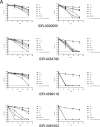Identification of Compounds with pH-Dependent Bactericidal Activity against Mycobacterium tuberculosis
- PMID: 30501173
- PMCID: PMC6371205
- DOI: 10.1021/acsinfecdis.8b00256
Identification of Compounds with pH-Dependent Bactericidal Activity against Mycobacterium tuberculosis
Abstract
To find new inhibitors of Mycobacterium tuberculosis that have novel mechanisms of action, we miniaturized a high throughput screen to identify compounds that disrupt pH homeostasis. We adapted and validated a 384-well format assay to determine intrabacterial pH using a ratiometric green fluorescent protein. We screened 89000 small molecules under nonreplicating conditions and confirmed 556 hits that reduced intrabacterial pH (below pH 6.5). We selected five compounds that disrupt intrabacterial pH homeostasis and also showed some activity against nonreplicating bacteria in a 4-stress model, but with no (or greatly reduced) activity against replicating bacteria. The compounds selected were two benzamide sulfonamides, a benzothiadiazole, a bissulfone, and a thiadiazole, none of which are known antibacterial agents. All of these five compounds demonstrated bactericidal activity against nonreplicating bacteria in buffer. Four of the five compounds demonstrated increased activity under low pH conditions. None of the five compounds acted as ionophores or as general disrupters of membrane potential. These compounds are useful starting points for work to elucidate their mechanism of action and their utility for drug discovery.
Keywords: Mycobacterium tuberculosis; antibacterial; bactericidal; drug discovery; pH homeostasis; phenotypic screen.
Conflict of interest statement
The authors declare no competing financial interest.
Figures



References
-
- WHO (2017) Global Tuberculosis Report; ISBN 978 92 4 156551 6.
Publication types
MeSH terms
Substances
Grants and funding
LinkOut - more resources
Full Text Sources
Other Literature Sources

